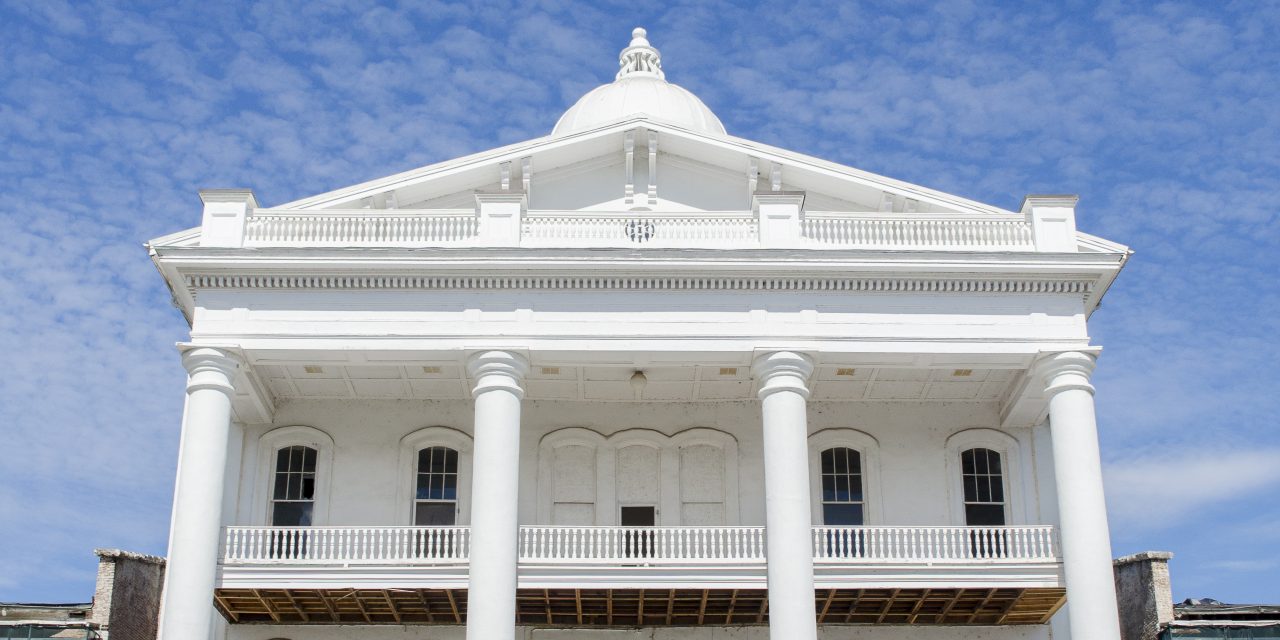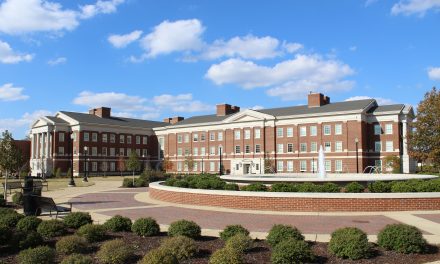STORY BY
Cristina Ausley
PHOTOS BY
Cristina Ausley & Becca Fleisig
DESIGN BY
Christian DelaCruz
In 1861, Bryce Hospital stood shrouded under an accumulation of looming oaks and a breadth of mystery. In 2000, flakes of eggshell paint curled from the walls, dusting a vacant hardwood floor in history and age, while two daunting wooden doors remained closed to the public. In just a few years, however, visitors will comfortably set foot under more than the iconic dome and the feel of an entirely rejuvenated character, they’ll step into The University of Alabama’s Performing Arts Academic Center.
Though a renovation and expansion for UA’s theatre and dance department has been on demand since 1972, former UA President Dr. Judy Bonner kickstarted the project alongside theatre and dance department chair, Bill Teague.
“After a few failed attempts to make things happen, somewhere around eight years ago Dr. Bonner approached me and said ‘I think it’d be great if we had a new theatre and dance complex,’” Teague said. “Of course I agreed with her, and the project was put into motion once and for all.”
The current theatre and dance department in Rowand-Johnson Hall was constructed in 1955, and the Marian Gallaway Theatre was opened in 1956 at UA, so the department is more than ready for an upgrade.
“The facilities that we have now have been in place for a very long time,” said Tricia McElroy, associate dean for Humanities and Fine Arts. “Our dance program and our theatre program make do, and they do a great job under our extremely talented faculty, but the Galloway was never really fitted out in the way it needed to be.”
Current UA President Dr. Stuart R. Bell has adopted Bonner’s hopes for a new performing arts center, in nowhere else but the former Bryce Mental Hospital.
“It was always Dr. Bonner’s vision that the new performing arts center was somehow tied to Bryce Hospital,” Teague said. “She felt it had been such a place of mystery for so many years to the Tuscaloosa people because it was always behind fences and walls, but now after an incredible transformation, it’ll be very public and very inclusive for the entire community.”
While the project will carefully renovate and restore Bryce’s original workings, the project will also construct an attached portion for theatres and performing studios unlike anything UA has had access to before.
The first floor will house a brand-new admissions office and welcome center, including a 150-seat video theatre. The second and third floors will house offices, classrooms, rehearsal studios and laboratories for theatre and dance students of all backgrounds and branches.
“So when people come to visit, instead of getting dropped off at the south end of the stadium with a cemetery across the street, they’ll drive up through these rows of beautiful trees on either side up to this brand new restored iconic ivory building.” Teague said.
The attached portion will connect to the original Bryce hospital via an assortment of bridges, leading to a 350-seat theatre to accommodate both large musicals and smaller, more intimate shows. Next door, a second more versatile 200-seat theatre will shift into both a thrust theatre or a theater in the round, in which the floor and structure can be refigured pending each performance layout. The dance portion of the Performing Arts Academic Center (PAAC) will host a 450-seat auditorium and a 5,000-square-foot dance studio theatre, in addition to a handful of dressing rooms.
“This project will be absolutely transformational,” McElroy said. “We’re talking about the best opportunities in lighting, in sound, in stage floor, in dance studios. Students will be able to stage productions, and learn how to use all of this equipment and technology so they’re ready for the professional world.” Though the massive undertaking features a handful of new material and opportunity, Teague and McElroy are two of many who are passionate about preserving and restoring Bryce’s original structure and history throughout the process.
“Hundreds to thousands of sketches have been drawn out to ensure this is done exactly as it ought to,” Teague said. “Yeah, it may have been a lot cheaper to bulldoze the building and start all over, but the architectural and historical significance of this building far outweighed those financial concerns, so there was no question this had to be done.”
Without a second thought, UA has drawn in specialists from across the country to properly maintain the vast history of Bryce, doing everything possible to make the restoration of the iconic building possible.
“One of the things I increasingly admire about this university is a willingness to recognize the past and not shy away from some of its difficulties,” McElroy said. “The Bryce history is interesting, and yeah, it has its darker moments too, but to transform it into a new use while remembering the history that was there to begin with in all of its extraordinariness and some of its difficulty—that’s what makes is transformative for me.”
Teague credits a handful of individuals for their pivotal roles in the lengthy rejuvenation project. He credits Dr. Bell and the college of arts and sciences for their support. He thanks former athletic director Bill Battle and his wife Mary, the current chairs for the fundraising campaign. Most of all, however, he seems to credits the theatre and dance students for their patience in the process.
“Our department population has almost tripled as the campus has doubled in size,” original Bryce hospital via an assortment of bridges, leading to a 350-seat theatre to accommodate both large musicals and smaller, more intimate shows. Next door, a second more versatile 200-seat theatre will shift into both a thrust theatre or a theater in the round, in which the floor and structure can be refigured pending each performance layout. The dance portion of the Performing Arts Academic Center (PAAC) will host a 450-seat auditorium and a 5,000-square-foot dance studio theatre, in addition to a handful of dressing rooms.
“This project will be absolutely transformational,” McElroy said. “We’re talking about the best opportunities in lighting, in sound, in stage floor, in dance studios. Students will be able to stage productions, and learn how to use all of this equipment and technology so they’re ready for the professional world.” Though the massive undertaking features a handful of new material and opportunity, Teague and McElroy are two of many who are passionate about preserving and restoring Bryce’s original structure and history throughout the process.
“Hundreds to thousands of sketches have been drawn out to ensure this is done exactly as it ought to,” Teague said. “Yeah, it may have been a lot cheaper to bulldoze the building and start all over, but the architectural and historical significance of this building far outweighed those financial concerns, so there was no question this had to be done.”
Without a second thought, UA has drawn in specialists from across the country to properly maintain the vast history of Bryce, doing everything possible to make the restoration of the iconic building possible.
“One of the things I increasingly admire about this university is a willingness to recognize the past and not shy away
from some of its difficulties,” McElroy said. “The Bryce history is interesting, and yeah, it has its darker moments too, but to transform it into a new use while remembering the history that was there to begin with in all of its extraordinariness and some of its difficulty—that’s what makes is transformative for me.”
Teague credits a handful of individuals for their pivotal roles in the lengthy rejuvenation project. He credits Dr. Bell and the college of arts and sciences for their support. He thanks former athletic director Bill Battle and his wife Mary, the current chairs for the fundraising campaign. Most of all, however, he seems to credits the theatre and dance students for their patience in the process.
“Our department population has almost tripled as the campus has doubled in size,” Teague said. “Right now, we have somewhere around 180 undergraduate dance majors, when we had zero 25 years ago. We had somewhere around 80 theatre majors in 2000, now we have 175. Between dance, musical theatre and theatre, we have almost 400 students. The growth has been incredible, and all of our students have been doing so well.”
Following somewhere around three more years of construction and renovation, Teague expects a massive burst in enrollment. McElroy believes the influence on the Tuscaloosa community will be even greater.
“The impact on the university and the department is obvious, but it is goingto have a huge impact on the community as well,” McElroy said. “This community will have a space to use and come to, and space to unite and socialize under; the impact extends far beyond the university.”
Despite the challenges that come with such a massive project, Teague and McElroy say they are inspired by the excitement and anticipation they see among students leading up to the official opening of the performing arts center.
“Words just cannot describe, they can’t even do it justice,” said Bitsy Seethaler, an avid dancer and Honors college public relations major. “The plans for this beautiful building, for the department, I can’t wait to come back and see everyone in action, enjoying the iconic space that has finally opened its doors.”
In an artful balance of old and new, an understanding of historical respect and restorative potential, a lengthy process of rejuvenated detail and new life, it’s no surprise the performing arts center will reflect a realm unlike any other. In the meantime, aspiring ballerinas lace up their satin slippers while anticipating actors warm up their voices, all in preparation for the resource that will take them one step closer to fame.
“I have said it before, I’ll say it again, and I hope everyone says it one day,” Teague said. “This building will be the crown jewel of the University of Alabama.”






